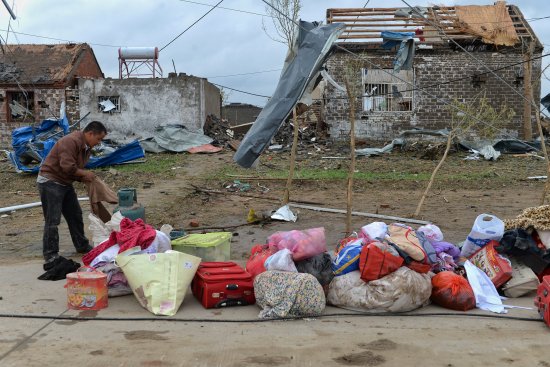
The death toll expected to rise as rescue workers continue to search through rubble
As the official death toll from Thursday’s tornado and hailstorm in eastern China rises to 98, with more than 800 injured, rescue workers continue to pick through rubble for survivors amid questions over whether building regulations were adequate and properly enforced.
At around 2:30 pm local time, the city of Yancheng, in Jiangsu province some 300 km north of Shanghai, was buffeted by winds of up to 125 km/h (78 m.p.h.), uprooting trees, flinging cars through the air and causing dozens of buildings to collapse.
Videos posted online showed bodies lying by the side of roads, the injured being transported to overflowing hospitals in pickup trucks and stunned survivors picking through the remains of their devastated homes. More than 200 people remain in critical condition, according to state news wire Xinhua.
“I heard the strong wind and ran upstairs to shut the windows,” Xie Litian, 62, told Xinhua. “I had hardly reached the top of the stairs when I heard a boom and saw the entire wall with the windows on it torn away.”
President Xi Jinping, currently on a state visit to Uzbekistan, called for the speedy resettlement of victims as well as the strengthening of meteorological monitoring and geological disaster assessment. Chinese state media described the tornado as the nation’s worst for half a century.
Nevertheless, the scale of destruction has shocked many. Although tornados are rare in China, there have been 36 deemed serious in Jiangsu province from 1961 to 2010 — the highest frequency in the country.
Each municipality in China has its own version of the national Load Code for the Design of Building Structures ordinance based on data from the local meteorological bureau. However, these typically only cover more frequent extreme weather phenomena such as typhoons. Following this disaster, questions will be raised about whether Jiangsu’s regulations should be enhanced, and whether current rules were followed at all.
“New buildings generally implement these regulations,” one academic who specializes in structural engineering and disaster reduction tells TIME, asking to remain anonymous because of the sensitivity of the subject. “However, there are also many old buildings without any safety design, especially in the villages.”
According to environmental campaign group Greenpeace, the tornado substantially damaged a hazardous chemical storage warehouse that stored large quantities of hazardous chemicals, including hydrofluoric acid, hydrogen chloride, ammonia and sulphuric acid and nitric acid. The group warned the release of these chemicals “could pose significant risk to public health and the local ecosystem.”
More than 1,300 police officers have been assisting with rescue efforts, while emergency supplies have been have been dispatched from Beijing. The densely populated area of Jiangsu province affected is known for textile factories and rice farming. Hailstorms accompanying the tornado also caused destruction to homes, shops and commercial buildings.
— With reporting by Zhang Chi / Beijing